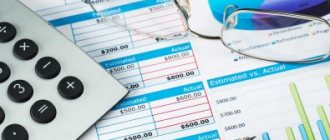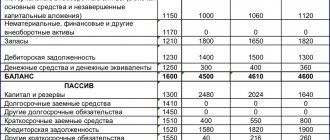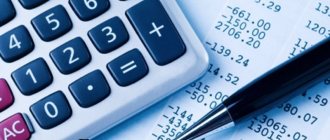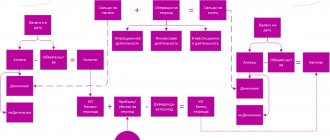Composition of financial statements
The Law “On Accounting” dated December 6, 2011 No. 402-FZ provides for the following package of forms, which is included in the financial statements of a legal entity:
- balance sheet;
- income statement;
- applications.
The balance sheet is a reflection of the state of the enterprise as of the reporting date, and the financial results report shows the results of its activities for the reporting period. From this it becomes clear that in the balance sheet it will be possible to find only the accumulated profit or loss for a specific date. Moreover, this indicator will not provide an understanding of the amount of profit from sales over the entire history of the company. Line 1370 of the “Capital and Reserves” section reflects the balance of account 84. This means that the indicator is equal to the amount of accumulated losses or profits received (not only from sales, but also taking into account non-operating income and expenses) minus expenses that were incurred at the expense of profits (this could be, for example, accrued dividends, the formation of reserve capital and other expenses).
Income statement
Form 2 is one of the most famous forms; it is intended for drawing up a statement of financial results. There are some features of entering information about value added tax into it.
This form is a reporting form and contains information about income and expenses. In the law that was in force until 2013 (according to 129-FZ), this document was called the “Profit and Loss Statement”.
The form represents a table that displays information about the reporting period and date, information about the organization and unit. measurements. The table with reporting information must have columns - number, name of data, codes, size of the indicator for the reporting period and the previous one.
Revenue is reflected in line 2110. It displays income, turnover on the credit of account 90-1, reduced by turnover on accounts 90-3, 90-4. In addition to the table, the form of this form must directly contain the name of the document, the date for which period it was generated, the name of the organization, INN, type of activity, general public fund. Thus, the financial results report is created on a special form and filled out in accordance with existing rules.
Calculation formula
The development strategy of any enterprise is based on data on sales prices and production scales. These categories are determined based on the experience of previous periods, taking into account all external factors. And revenue is a general indicator that gives an idea of the dynamics of the organization’s development.
Revenue is the sum of all funds received by the enterprise during the period under study from the sale of goods, services, and property rights. It can be expressed both in cash and in kind and calculated without taking into account value added tax and excise taxes (we talked about what is considered sales revenue in more detail here).
It is this indicator that is taken as the main one when calculating income and profit from core activities. It excludes expenses and amounts received from activities not related to the sale of goods and services.
The calculation algorithm is quite simple. Sales volume and unit cost information are required. If the price changes during the reporting period, it is necessary to calculate revenue taking into account each change.
Revenue is calculated taking into account the volume of sales completed and the cost in effect at the moment. Discounts, VAT, excise taxes and export tariff charges are not taken into account.
Today, there are two methods by which revenue is calculated:
- Cash (based on actual sales volume).
- Accrued (based on the fact of receipt of income, regardless of whether payment has already been received or not).
Cash is used for internal assessment of the enterprise’s activities and is not reflected in the reporting.
The calculation method is as follows: TR = Res.p (n) + GP - Res.p (k) , where:
- Res.p (n) and Res.p (k) – balances of finished products at the beginning and end of the reporting period.
- GP – finished products that are planned to be sold.
All calculations are expressed in monetary terms.
This indicator is calculated, as a rule, based on the results of the period, once a quarter and annually. The price and volume of products sold are internal information and are not reflected in the financial statements.
We provide more details about the formulas used to calculate revenue in a special article.
What is it and where can I see it?
At the end of the reporting period, management needs comprehensive information about the return on assets and profitability of the enterprise. Accordingly, it is necessary to know the amount of revenue and expenses. For this purpose, a balance sheet is prepared.
The balance sheet is not only information for reporting to the Federal Tax Service, it is a source of data for analyzing the current activities of the enterprise and making forecasts. This is a document showing the financial position of an enterprise at the reporting date, the value of assets and the amount of capital of the organization, as well as the amount of its liabilities.
As for revenue, there is no separate line for it in the balance sheet. This, surprising at first glance, circumstance is explained by the fact that the assets and liabilities of the enterprise are reflected in the balance sheet at the moment in question. Whereas the sold product or service is no longer an asset. And the financial results, which include revenue, are reflected in the income statement.
Sometimes it is still possible to define a line item for revenue on the balance sheet. This is a case where the finished products sold were not paid for. Revenue from the sale of finished products is usually represented by the following entry: Debit of account 62 “Settlements with buyers and customers” – Credit of account 90 “Sales”, subaccount “Revenue”. Read about which accounting account revenue can be displayed in here.
Thus, customer debt equal to revenue from the sale of goods and services of the enterprise will be reflected in line 1230 “Accounts receivable”.
Attention! Balance sheet revenue in line 1230 is indicated with VAT, and in the profit and loss statement net revenue is indicated - this is the amount reduced by the VAT accrued on revenue.
On what account is it reflected?
In accordance with the Chart of Accounts and Instructions for its application, developed by the Ministry of Finance dated October 31, 2000, the main account for recording revenue is account 90 - “Sales”.
Postings can be reflected like this:
- Revenue from the sale of goods, debit – “62” “Settlements with buyers and customers”, credit “90”, subaccount “Revenue”.
- The cost of goods sold is written off, debit – “90” “Cost of sales”, credit “41” “Goods”.
- VAT is charged on the cost of goods sold, debit – “90” subaccount “VAT”, credit – “68” “Calculations for taxes and duties”.
We offer a video lesson on the topic “Account 90 “Sales” in accounting: entries, examples”:
Balance line
Financial accounting statements are heterogeneous; they include several documents filled out separately by economists. Among them is the income statement, which, in turn, includes the balance sheet.
Important! In accordance with the provisions of the Federal Law of December 6, 2011 “On Accounting”, reporting means the provision of reliable data on the results of the company’s work and cash flow.
Revenue: line 2110
The line is intended to reflect information about revenue (profit received from ordinary activities). Let us remind you that, in addition to revenues from sales of products, goods and services, this includes the following income items:
- for work performed;
- license fees, commissions and royalties;
- rent;
- proceeds related to injections into the authorized capital of other companies.
Average monthly calculation as an indicator of enterprise activity
Why does an entrepreneur need to know how to calculate the average monthly turnover on a current account ─ for the correct use of working capital. Standardization in production helps with this, which means the correct distribution of materials and raw materials for use, this will give stable operation to the enterprise. To do this, use all the data obtained during the average monthly turnover calculation.
The average monthly calculation as an indicator of the enterprise’s activity is important for the tax office and potential investors.
Experts recommend using the “net turnover” indicator to analyze the flow of funds, which is necessary for business activities, ─ when income transactions are separated from money received as charity.
To determine the net funds in circulation for a particular enterprise, indicators such as the scale of the activity are used, as well as the needs of the enterprise and the specifics of the type of activity.
Experts recommend maintaining a “net turnover” balance, since excess capital or its lack affects the well-being of the business. When financial organizations can talk about the misuse of resources by an entrepreneur, his ineffective activities, and when there is a lack of net capital, this shows the businessman’s failure to meet his obligations.
The rapid development of market relations throughout the world has aroused great interest among the population in knowledge and understanding of the basic concepts of financing. Terms that were previously used only in the professional environment and specialized literature are now increasingly appearing in periodicals and rolling off the tongues of Russians who are far from accounting.
Thrifty owners still resort to a simplified version of accounting, counting all income received in one part of the sheet, and expenses incurred in the other. Thus, “debit” and “credit” are used quite often in everyday life. Determining these values using simple mathematical calculations allows you to judge the effectiveness of the money spent and subsequently plan ways to reduce costs. This method is the most reliable on the path to financial well-being.
Relationship with current assets
All information on current assets is reflected in the second section of the balance sheet. And an indicator of the company’s revenue can be the amounts that have been received by the company’s cash desk or into its current account. These amounts are reflected in the line “Cash and equivalents” of the second section of the balance sheet and, in fact, are the organization’s revenue.
The cash balance makes it possible to analyze the success of cash flow management at the enterprise. If large sums of money are reflected in the balance sheet, then it is possible that the company’s activities bring high profits, and managers do not have time to put them into circulation.
If the balances are low, then there may be a competent distribution of funds received from the sale of goods or services. That is, management acquires assets in a timely manner and makes financial investments, efficiently managing the finances of the enterprise.
But in this case, it is necessary to pay attention to the profitability of the enterprise, because small amounts of balances on the balance sheet may indicate a shortage of the company’s own funds.
Important! An important point is whether the proceeds go to the company’s cash desk or to a current account. Since upon receipt at the cash desk, it is possible to exceed the established limit, which is an administrative offense (Article 15.1 of the Administrative Code).
Results
There is no line item on the balance sheet to record revenue.
But the amount of the company's assets and liabilities reflected in this main accounting report, as well as their changes, may indirectly indicate an increase or decrease in the company's revenue. And vice versa. Thus, there is a connection between balance sheet indicators and revenue. You can find more complete information on the topic in ConsultantPlus. Free trial access to the system for 2 days.
In Form 2, the profit and loss statement of OPIU
Profit and loss statements are one of the main forms of accounting reports that legal entities are required to prepare and submit to the appropriate authorities. The modern form is called a financial report. results. The final results in the report show what the organization's activities were for the period.
Using the report, you can analyze indicators over time, as well as at the time the report was compiled. It reflects VAT and other data. It is mandatory to submit documentation to the Federal Tax Service and Rosstat.
The report, which is prepared for intermediate dates, may be required by the economic service, financial institutions, and counterparties. The structure of the report should include information on the period for which it was compiled, as well as information about the date of preparation, TIN of the legal entity, reference table, signatures of managers. It is important to reflect VAT on the balance sheet.
We can say that the profit and loss statement, or more precisely, a document containing data on financial results, includes data on which indicators of income and expenses formed the result of the work of a legal entity.
Balance sheet profit in accounting
Balance sheet profit in accounting can be obtained using accounting accounts. Profit or loss from the activities of an organization is obtained as a result of the accumulation of a certain amount during the year on the balance sheet account 99 “Profit and Loss”. These values are also reflected in accounts 91 “Other income and expenses” and 90 “Sales”.
It turns out that the balance sheet profit or loss consists of the turnover of account 99 in correspondence with accounts 90 and 91.
When calculating book profit, do not take into account the amount of income tax payable (the current tax is line 2410 in Form 2). Taxes are reflected in account 68. Also, do not take into account the final closing of account 84, which turns the accumulated profit or loss of the current year into profit or loss of previous years.
Actions if the amounts in the declarations differ
From the moment the ASK VAT information system, which was introduced by the Federal Tax Service, began to function, taxpayers began to receive requests for explanations regarding discrepancies much more often. The peculiarities of this program are that it operates automatically and can, based on some of the specified criteria, identify errors in reporting.
Discrepancies can be internal or with counterparties. Internal discrepancies in the declaration may arise if deduction amounts that contain kopecks have been rounded. The limit of permissible discrepancy should be no more than 10 rubles. If these discrepancies are identified, as well as inconsistencies with counterparties, explanations may be required.
If there are differences in the data in the declaration and in the balance sheet, the fiscal authorities may also have questions for the payer. Tax officials compare declarations with accounting records. In case of discrepancies, there is a risk of claims arising during a desk inspection, as well as during an on-site inspection.
One of the mistakes may be the larger amount of accounting income than tax income. If tax revenue exceeds accounting revenue, this will not cause serious problems. However, otherwise, the tax authorities may consider that the tax base is underestimated.
If the tax authority requires explanations, they must be sent within 5 business days after the message with the request is received. Explanations must be provided in writing.
Convenient analytics for organizational management
It is more convenient for management to estimate revenue in the context of management reports. They are located in the “Manager” menu in the “Sales” section.
Inside the section, analytics are presented in sections:
- by counterparties, incl. on payments and sales comparison;
- by nomenclature and nomenclature groups, incl. comparison;
- gross profit.
Accordingly, you can select each of these reports. In essence, it will duplicate the information contained in the accounting reports, but in a language more understandable to the manager.
First, these reports present metrics in both graphical and tabular form. Which more clearly represents the financial position of the company.
Secondly, the reports indicate the top five, leading by counterparties or by product range, which allows us to draw the appropriate conclusions.
Let's look at each report separately.
Revenue and debt
Information about the company's borrowed funds is contained in sections 4 and 5 of the balance sheet. The relationship between this information and revenue is very weak, but it exists.
Borrowing money is a dangerous and burdensome operation. Dangerous because there is a possibility of not repaying the debt and even going bankrupt. Burdensome if paying interest on borrowed funds consumes all working capital, and there is no money left for current expenses. There is nothing to buy raw materials, nothing to pay wages and taxes, nothing to pay for electricity and heat, that is, the production process is under threat. As a result, disruptions occur in the supply of finished products to customers. And where there is no sales, there is no revenue.
IMPORTANT! Now companies do not need to standardize interest on borrowed funds for the purpose of calculating income tax (Law No. 420-FZ dated December 28, 2013). This is true for all debt obligations, except those that arose as a result of controlled transactions.
Grouping of accounting transactions
With the help of accounts in the accounting department, diverse business transactions are systematized, taking into account the sources of their formation. The double registration method displays changes in property ownership, sources of its formation and all types of economic activities on corresponding (that is, interconnected) accounts. Double entries are made in the same amounts in debit and credit. The final balance of active accounts is determined by adding the debit turnover to the initial balance and subtracting the credit turnover. There cannot be a credit balance (neither final nor initial) in an active account, since this means that the accounted object is less than zero. The final balance on a passive account is determined similarly: the initial balance plus the amount of credit turnover and minus the amount of debit. The resulting final balances for passive accounts are reflected as a credit, and for active accounts - as a debit. Active-passive accounts display both the property of the organization and the sources of its formation. The use of double entry, reflecting each business transaction, is due to the clear relationship of these transactions with changes in the financial condition of the enterprise, in which the interaction of two accounting objects occurs. It is this interaction that is called the economic content of a specific business transaction. Thus, displaying the debit and credit of each operation makes it possible to obtain detailed information about the dynamics of the development of the entire production as a whole and to determine priority directions for its development.
Which accounting entry reflects profit from the sale of products?
To account for income and form the cost of goods sold, work or services, account 90 “Sales” is used. Depending on the type of activity and the specifics of the organization’s work, the entries to reflect the receipt of revenue and write-off of expenses may differ. But the reflection of profit or loss from sales will be the same regardless of what activity the company conducts.
To properly understand how profit from sales is formed, it is best to analyze which turnovers fall into the 90th account:
- Revenue is reflected by posting Dt 62 Kt 90.1. But in retail trade, the wiring will look like Dt 50 Kt 90.1 or Dt 57 Kt 90.1.
- The cost of services and work is written off with such entries as Dt 90.2 Kt 20 (23, 26, 25, etc.). In wholesale trade, the cost of goods will be written off using the operation Dt 90.2 Kt 41, and sales expenses - Dt 90.2 Kt 44. In retail, you additionally need to take into account the markup Dt 90.2 Kt 42. And in production, the cost of finished products will be written off using the entry Dt 90.2 Kt 43.
- VAT for any type of activity will be charged by posting Dt 90.3 Kt 68.
- Profit from sales will be reflected in the accounting record Dt 90.9 Kt 99.
- The loss from sales will be reflected by the posting Dt 99 Kt 90.9.
IMPORTANT! In some accounting programs, subaccount numbers may differ from the Chart of Accounts approved by the Ministry of Finance. In addition, the organization can change, delete or introduce additional sub-accounts independently if required by the specifics of its activities.
The amount of the posting in correspondence with account 99 will be equal to the profit or loss received from the sale. That is, the amount of revenue minus cost, VAT and excise taxes, if any. If the calculation is correct, the collapsed (without analytics) balance of account 90 should become zero at the end of the period. The presence of a balance will mean that the formation of the entry for writing off profit (loss) was made with an error.
When reforming the balance, it is necessary to close the 90th account. This event involves writing off the balance of all subaccounts to account 90 to account 90.9. These can be operations such as (if there is turnover during the year):
- Dt 90.1 Kt 90.9 - for writing off revenue turnover during the year;
- Dt 90.9 Kt 90.2 - for writing off turnover at cost;
- Dt 90.9 Kt 90.3 (90.4) - for writing off turnover based on accrued VAT or excise taxes.
The balance on account 90.9 (as well as on account 90 as a whole) should become zero automatically after the above operations. If this does not happen, you should look for an error in the wiring.
Revenue accrual method
Revenue can be recorded on the balance sheet in two ways.
- Cash register . Revenue includes only money actually received into the account. Cannot apply: banks, credit cooperatives, microfinance organizations, mining companies, small businesses (revenue for the previous 4 quarters is less than 1 million rubles).
- Under the accrual method . Revenue includes all income in the reporting period, regardless of whether the funds actually arrived in the account or not.
Profit and income of the enterprise
Setting prices at current prices.
When setting a price for its product, an enterprise is based on the prices of competitors and pays less attention to its own costs.
The amount of markup or VAT in the retail price is determined by the formula:
N = Price * (surcharge or VAT / (100 + surcharge or VAT)),
15,25 = 18/118,
Price * 15.25 = 95 * 0.1525 = 14.48 - VAT in the price (95 rubles)
Profit (net income) is the final financial result of entrepreneurial activity (net income).
Profit = Cash proceeds from product sales - cost of products sold
Gross gross revenue is determined at actual sales prices, taking into account VAT and excise taxes.
Net gross revenue is determined without VAT and excise taxes. Typically, gross revenue means net gross revenue, since it underlies the determination of profit.
Form No. 2 “Profit and Loss Statement”:
- Gross profit
— Profit (loss) from sales
— Balance sheet profit (loss)
— Profit (loss) before tax
— Net profit (loss) of the reporting period
Gross profit = Revenue from the sale of goods (works, services) – production cost of goods sold
Sales profit = Gross profit - selling expenses (distribution expenses) - administrative expenses (general expenses)
or
Profit from sales = Revenue from the sale of goods (works, services) – full cost of products sold
Balance sheet profit = Profit from sales + (-) Balance of other income and expenses
Profit (loss) before tax = Balance sheet profit reduced by the amount of income that is subject to independent taxation and the amount of benefits.
Net profit (loss) of the reporting period = Profit (loss) before tax - income tax and other similar payments
Balance sheet profit is adjusted, that is, reduced by types of income that are subject to independent taxation (from equity participation in the activities of other enterprises; dividends, interest on securities owned by the enterprise; from holding concerts and entertainment events in open areas, stadiums; from the operation of casinos , video salons, slot machines).
The amounts of profit for which tax benefits have been established are excluded from the balance sheet profit (part of the profit that goes to the maintenance of healthcare institutions, cultural and social spheres, etc., which are on the balance sheet of the enterprise, profit directed to finance capital investments for industrial purposes is exempt from tax)
| Index | Line code | Reporting year, thousand rubles |
| 1. Revenue (net) from the sale of products (works, services, minus VAT, excise taxes and similar mandatory payments | ||
| 2. Cost of goods, products, works sold | ||
| 3. Gross profit (10 – 20) | ||
| 4. Business expenses | ||
| 5. Management expenses | ||
| 6. Profit (loss) from sales (29– 30 – 40) | ||
| 7. Other income and expenses: | ||
| — Interest receivable | ||
| - Percentage to be paid | ||
| — Income from participation in other organizations | — | |
| - Other income | ||
| - Other expenses | ||
| 8. Profit (loss) before tax (50 + 60 – 70 + 80 + 90 – 100) | ||
| Deferred tax assets | — | |
| Deferred tax liabilities | — | |
| Current income tax | 74,8 | |
| Income tax adjustment | — | |
| Penalties on taxes | — | |
| 8. Net profit (loss) of the reporting period | 299,2 |
Income:
1. Income from ordinary activities:
— Revenue from sales of products and goods
— Receipts related to the performance of work and provision of services
2. Operating income:
— Interest and dividends receivable
— Royalty
- Rent
— Receipts the receipt of which is associated with the provision for temporary use of one’s assets, intellectual property, etc., for a fee, when this is not the subject of the organization’s activities
— Proceeds from the sale of fixed assets
— Unrealized profit resulting from the revaluation of marketable securities
3. Non-operating income:
— Fines, penalties, penalties for violation of contract terms
— Assets received free of charge (including under a gift agreement)
— Proceeds for compensation of losses caused by organizations
— Profit of previous years recognized in the reporting year
— Amounts of accounts payable and depositors for which the statute of limitations has expired
- Exchange difference
— Amounts of revaluation of assets (except for non-current assets)
— Other non-operating income
4. Extraordinary income - income arising as a consequence of emergency circumstances, insurance compensation, the cost of material assets remaining from the write-off of assets that are not suitable for restoration and further use
Gross income (net product) = Cash revenue – material costs
or
Gross income = Salary + Profit
How debit and credit turnover is used
You don’t know how to calculate the average monthly turnover of a current account for a bank ─ then let’s look at what debit and credit are used for. Records of turnover in the current account are kept separately:
- the entrepreneur's debit is indicated on the left side of the current account;
- the right side of the account is reserved for credit turnover.
Depending on what kind of operation the entrepreneur carries out, this is accordingly reflected in one or the other side of his account. The balance (the difference between income and expense) in an account is also divided by type, this is:
- active result;
- passive result;
- active-passive balance.
When an increase in the value in debit turnover occurs in the account, this indicates the property expansion of the enterprise or an increase in sales from trade; accordingly, a decrease in these parameters characterizes the entrepreneur’s credit.
You must understand that passive accounts are necessary only to show how the entrepreneur receives money and through what actions this happens.
The accounting department of a small business usually balances debits and credits once a year, or quarterly, when the balance for the reporting period is displayed. When the balance is zero ─ the debit column equals the credit column, the account is reset to zero.
General characteristics and significance of gross profit for production development
Competent management of the production and commercial activities of any enterprise is impossible without regular monitoring of financial indicators.
To monitor the turnover of funds, financial statements are generated. Gross profit is one of the significant indicators of a company's economic potential.
The indicator expresses the financial result of all aspects of the company's activities. The value is reflected in the balance sheet.
The total value expresses the influence of external and internal parameters on the success of the enterprise. For convenience, they are divided into 2 groups.
The first shows the dependence of VP on the organization within production.
Its value is influenced by such parameters as:
- Cost of production.
- Commodity coefficient.
- Volume of production.
- Product quality.
- Degree of utilization of production capacity.
In addition to these intra-production reasons, the increase or decrease in gross profit is influenced by environmental parameters.
Among them are:
- Location of the company.
- Regulatory framework.
- Political and economic situation in the country.
- The natural environment.
Analysis of the parameters that affect the amount of gross profit is necessary to make a decision on the feasibility of a particular type of activity in a particular region. With the help of this tool, profitable or unprofitable areas of business are identified, and guidelines for new ways to solve financial problems are obtained.
What is gross profit and how does it differ from net profit?
Gross profit is considered one of the main indicators characterizing the efficiency of an enterprise. It is calculated as the difference between:
- net revenue from the main activity,
- the cost of goods or services.
Based on the obtained value, one can indirectly judge the profitability of the enterprise. Indirectly - since the indicators taken into account do not reflect complete information.
Thus, the term “net” in relation to revenue means that it is necessary to subtract from it:
- VAT,
- excise taxes,
- other obligatory payments (for example, export duties).
The cost indicator is formed by:
- costs of production and provision of services;
- the purchase price of the goods sold.
Commercial and administrative expenses are not included in the cost price; they are reflected in the financial performance statement separately and participate in the formation of the net profit indicator (clause 23 of PBU 4/99).
Actually, this is the difference between gross profit and net profit. The first serves, rather, to assess production costs, pricing efficiency, and return on production, since it is formed from indicators that are directly related to production.
While net profit is the final financial result of the enterprise’s activities for the reporting period, calculated as the difference between all recognized income and expenses (including taxes and mandatory payments).
Measures to increase gross profit
Calculation of VP, analysis of all its elements, identification of accompanying and impeding factors are aimed at increasing the profitability of the enterprise. Economic theory and practice have in their arsenal tools for increasing gross profit.
Here they are:
- LIFO technique.
- Tax benefits.
- Writing off bad debts.
- Reducing costs.
- Flexibility in pricing.
- Use of high technologies.
- Improving the quality of products and services.
- Increased control over intangible assets.
Help: LIFO method
(
LIFO
) - a method of accounting for inventory in value terms at the price of the last batch manufactured or received. In accordance with this method, inventory items that were registered last are removed from the register first.
Intensification of production processes, the use of high-tech equipment, high-quality raw materials, reasonable organization of labor, and the use of modern technologies are factors that ensure the liquidity of products and, as a result, increase VP.
Gross profit is the amount of money remaining in a company's account after subtracting production expenses. The numerical value is determined by the formula. Calculation details vary depending on the type of business. The indicator is necessary for assessing technological production resources. VP helps to rationally formulate the commodity value of products. The value is reflected in the financial statements through entries approved by order of the Ministry of Finance.
How to calculate average monthly turnover
How to calculate the average monthly turnover on a current account, and for what purposes is this necessary, ─ and also when it is recommended to calculate the turnover of a small enterprise, this will become clear when an entrepreneur analyzes the stages of the flow of funds through his own business.
Experts say that when the speed of movement of financial resources through the stages of production is high, and working capital circulates quickly, then the profit of entrepreneurial activity grows rapidly. Let's look at how to correctly calculate the average monthly turnover:
- You need to calculate how your assets turn over, as well as how long one turn takes. To do this, you need to divide the profit received by the average monthly value of the entrepreneur’s asset. This is reflected in the formula: K (turnover) = average monthly profit/asset value. The result shows how much turnover the invested assets pay back; if the indicator increases with each calculation, this means an increase in the company’s sales activity.
- The duration of one revolution can be determined by dividing the time interval of your choice by K (revolutions). A good indicator here would be a decrease in value, which indicates a shorter payback time.
- You also need to calculate the coefficient that shows the fixedness of active funds; to do this, you need to divide the average parameter of the assets involved in the turnover by the profit received for the analyzed time interval. This ratio shows the entrepreneur how much working capital was needed to generate one ruble of profit.
- It is also necessary to calculate the operating cycle, which is equal to the sum of: how long raw materials and supplies are in circulation, how long products are sold, how much unfinished products are left for the study period, and what debt is owed to the entrepreneur from contractors. By regularly carrying out this calculation, an entrepreneur can track the moment when an increase in the indicator will indicate the beginning of a decrease in business activity of his own production. During the same period, the company’s funds will begin to turn over more slowly.
- We determine the duration of financial cyclicality. To obtain this indicator, it is necessary to subtract the duration of the turnover of debts not returned to the entrepreneur from the calculated operating cycle. The lower this indicator, the more successfully the businessman runs his own business.
Reflection of gross profit in the balance sheet
Line 2100 of the income statement is devoted to gross profit indicators. The calculation uses information from line 2110, showing sales revenue and information about the cost of production from line 2120. The difference between these indicators gives the gross profit values. A negative value indicates that the business is unprofitable. The value is written in parentheses without the minus.
The concept of the VP coefficient
Gross profit as a percentage is called the VP ratio. The value shows the ratio of total profit to revenue. A high ratio indicates the profitability of the business and confirms the appropriate level of cost control. A low percentage indicates poor return on costs for the manufacture, production and sale of products.
The VP coefficient is an important indicator for monitoring the company’s activities in the local segment of the economy. Determines its place among its competitors and gives an idea of the rate of economic growth.
The importance of gross profit for long-term business development
The indicator reflects the financial result against the background of total production costs; the coefficient takes into account not only the cost of production, but also the costs of management, sales, and foreign economic relations.
Reference: TCtechn — technological cost. Reflects shop costs, cost of raw materials, and employee wages.
This includes costs for finding partners, marketing products, concluding contracts, and signing agreements. In total, these costs relate to the technological cost of the product.
The general terms of the VP coefficient are divided into subaccounts or expenses of the second row.
General view of the VP formula
Gross profit is withdrawn after receipt of revenue. From the amount received from the sale of goods (TR), the product cost indicator (TCtechn) is subtracted and the gross profit (GP) is obtained.
Attention: the classic formula looks like this: GP = TR - TStechn.
What is debit and what is credit - history of terms
What is debit and what is credit is better understood, according to experts, when you “immerse” in more detail into the origin of these words. The expression “debit” is a borrowed word that was previously used in German speech, but, according to historians, its roots come from the Roman Empire (Debitum), which means debt. The shorter spelling Debet is adopted, which defines the expression "he owes", a more complete meaning (property abbreviation).
English also has a similar word, which our translation defines as “debt.” The European country France uses the word debit to define expenses as something physical; it is used in specific definitions of the consumption of gas, oil, water, when the source provides resources for a specific time interval, but the physical value is written a little differently, with the letter “and” ─ debit, in contrast from the accounting definition of debit.
Most often, the terms debit and the term credit are used in accounting when accounting for funds and finances, namely:
- Each accounting department has a “passive”, “active” and “mixed” account, these are:
- active accounts - an organization or company, an enterprise opens (places) independently;
- passive accounts - those that use funds raised for the organization’s activities;
- “debit”, in relation to “active” and “mixed” (active-passive) accounts, determining the receipt of additional funds;
- “credit” means the expense of active or active-passive accounts;
- “debit” in a passive account ─ expense of funds;
- “credit” in a passive account ─ the receipt of additional funds.
- For a better understanding of what debit is, it should be noted that any accounting consists of two parts, these are:
- the property part of the enterprise (debit), its left side of accounting;
- the growth of the organization’s property and the rights to use it are shown on the left side (debit) of the accounting report for active and active-passive accounts;
- the presence of obligations of the organization, what “cuts” in the sources of its own financing of activities are reflected in passive accounts, in its debit part.
- The right side (credit) of accounting is defined by specialists as:
- reduction of the organization’s property assets in the operation of active or active-passive (mixed) accounts;
- An increase in the company’s finances (credit) is reflected in the passive account on the right side of the accounting department.
- Experts determine the following patterns:
- “active” accounts show how the organization’s funds move from the credit part to the debit part of the accounting department;
- “passive” account reflects the movement of money of an enterprise or organization from the debit part to the credit part of the accounting department;
- When compiling a balance sheet, the accounting department shows debit balances as Assets and credit balances as Liabilities.
Experts emphasize that the definition of “debit” and the definition of “credit” are two opposing concepts. They also have different signs and meanings, namely:
- when the assets of an organization are considered, debit turnover is a positive value, it characterizes the growth of the enterprise’s finances, and credit turnover reflects their decrease;
- When considering the obligations of an organization or company, credit turnover shows financial growth.
View more:
Materials Postings by Arrival MAIN PAGE TAX NEWS ACCOUNTING NEWS ACCOUNTING ANNUAL REPORT AND…
Is it often punished under paragraph 1 of Art. 126 Tax Code of the Russian Federation?P. 1 tbsp. 126 Tax Code of the Russian Federation...
Transactions with real estate for a fee or on a contract basis. Subclass 68.3 contains two groups of codes: ...
Double TaxationDouble taxation is the simultaneous imposition of the same taxes on income in different countries. Double taxation is caused by...
Department of Rosprirodnadzor for the Crimean Federal District, Kerch Selection of a territorial bodyCentral apparatus of Rosprirodnadzor02 Department of Rosprirodnadzor for…
What to do if the wiring is incorrect?
If such a problem occurs, we advise you to sort out the settings of your 1C. To change accounts receivable, follow the "Settlements" link at the top of the document. You can change accounts in the table itself; they are indicated for each product or service.
Attention! It is better to set up accounts correctly once than to correct them every time in a finished document.
For individual entrepreneurs
The document includes only three columns:
- in the first, the individual entrepreneur enters the date of the operation;
- in the second, he enters the proceeds from the sale of goods or services;
- in the third, indicates the document on the basis of which the volume of goods was reduced/their value was changed/returned – if any.
Data is entered every month , and the results are summarized below in the “Total” line.
For LLC
- No.;
- date and number of the primary document;
- Contents of operation;
- income taken into account when calculating the single tax;
- expenses that are also taken into account when calculating the tax.
Now you know how to correctly reflect revenue from the sale of goods or the sale of services in an accounting report. All features of financial statements are reflected in Russian legislation. Once again, we note that the main thing is the correct wiring setup. If the document does not turn out as expected, simply double-check all the accounts in the 1C program.
Sources
- https://nalog-nalog.ru/buhgalterskaya_otchetnost/godovaya_buhgalterskaya_otchetnost/po_kakoj_stroke_otrazhaetsya_pribyl_ot_realizacii_v_balanse/
- https://expert-nds.ru/vyruchka-v-balanse/
- https://101million.com/buhuchet/prochie-raschety/vyruchka/v-buhgalterskom-balanse.html
- https://101million.com/buhuchet/prochie-raschety/vyruchka/ot-realizatsii/kak-otrazhaetsya.html
- https://nalog-nalog.ru/buhgalterskaya_otchetnost/sostavlenie_buhgalterskoj_otchetnosti/kak_otrazhaetsya_vyruchka_v_buhgalterskom_balanse/
- https://raydget.ru/2261-balansovaya-pribyl/
- https://kakrabotat.ru/ya-predpinimatel/chto-takoe-valovaya-pribil.html
- https://nalog-nalog.ru/buhgalterskij_uchet/po_kakoj_stroke_otrazhaetsya_valovaya_pribyl_v_balanse/
Gvmp
It is better to trust financial and accounting issues to professionals - this will save your time and help avoid annoying misunderstandings.
Take note: you can always get expert help by contacting the Glavbukh Assistant service.
A document that standardizes the account in which sales revenue is reflected is the Chart of Accounts for accounting the financial and economic activities of organizations.
According to Section VIII of the regulations, accounting under account 90 “Sales” registers information on the income/expenses of the company’s main business and balances its financial results. Account 90, which reflects revenue, is one of the most difficult to account for and its specificity is due to the fact that sales include not only the revenue side, but also the expense component of a multi-stage process. The plan provides for the opening of sub-accounts:
- 90/3 “Value added tax” - to separate VAT from the sales value of products sold;
- 90/2 “Cost of sales” - for grouping costs by products sold;
- 90-5 “Export duties” - for accounting for export duties (an additional open sub-account is used);
- 90/9 “Profit/loss from sales” – for balancing the financial result from sales for the month.
- 90/4 “Excise taxes” - to allocate the amount of excise duty from the selling price of products sold;
- 90/1 “Revenue” - for recording receipts of assets that are recognized as revenue;
We recommend reading: Compulsory medical insurance policy series where to watch
Subaccounts 90.3-90.5 provided for by the Plan are not used by all organizations.
Their use is related to the specifics of commercial activity, but according to the synthetic (generalized) 90th account, it is necessary to open additional analytics by type of sales - the range of goods, products, types of work, services, etc.







